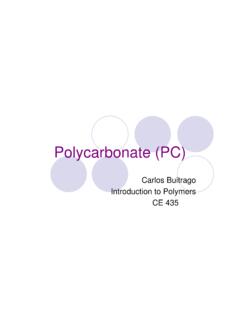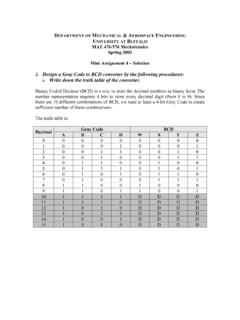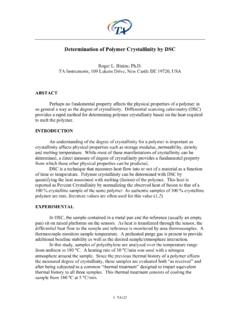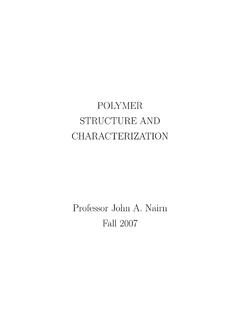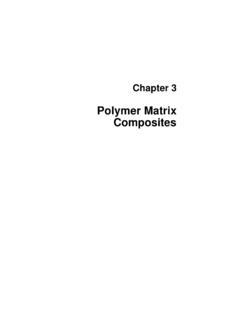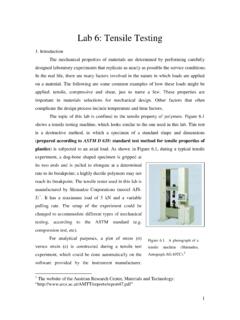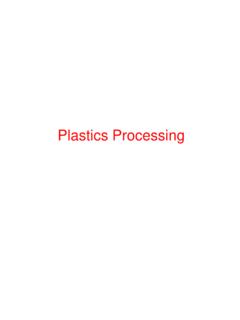Transcription of A review of polymer dissolution
1 A review of polymer dissolutionBeth A. Miller-Chou, Jack L. Koenig*Department of Macromolecular Science, Case School Engineering, Case Western Reserve University, 10900 Euclid Avenue,Cleveland, OH 44106, USAR eceived 13 November 2002 AbstractPolymer dissolution in solvents is an important area of interest in polymer science and engineering because of its manyapplications in industry such as microlithography, membrane science, plastics recycling, and drug delivery. Unlike non-polymeric materials, polymers do not dissolve instantaneously, and the dissolution is controlled by either the disentanglementof the polymer chains or by the diffusion of the chains through a boundary layer adjacent to the polymer solvent interface. Thisreview provides a general overview of several aspects of the dissolution of amorphous polymers and is divided into foursections which highlight (1) experimentally observed dissolution phenomena and mechanisms reported to this date, (2)solubility behavior of polymers and their solvents, (3) models used to interpret and understand polymer dissolution , and (4)techniques used to characterize the dissolution Elsevier Ltd.
2 All rights :Amorphous polymers; Diffusion; dissolution ; dissolution models; dissolution mechanisms; Permeation; polymer ; review ;Solubility; Solvents; SwellingContents1. polymer dissolution Surface layer formation and mechanisms of Effect of polymer molecular weight and Effect of polymer structure, composition and Effects of different solvents and Effect of environmental parameters and processing polymer solubility and solubility Thermodynamics Estimation of solubility Group contribution methods of calculation of solubility Thexparameter and its relation to Hansen solubility Techniques to estimate Hansen solubility parameters for Predicting polymer polymer dissolution $ - see front matterq2003 Elsevier Ltd. All rights (03)00045-5 Prog. Polym. Sci. 28 (2003) 1223 *Corresponding author. Tel.: 1-216-368-4176; fax: ( Koenig).
3 Phenomenological The multi-phase Stefan Disengagement dissolution by mixed Drug release from a polymer External mass transfer External mass transfer model External mass transfer model Stress relaxation and molecular Kinetics of The reptation Anomalous transport models and scaling Scaling dissolution clock The single phase Molecular theories in a continuum dissolution of a rubbery dissolution of a glassy Molecular model for drug release Molecular model for drug release Techniques used to study polymer Differential Optical Steady-state Nuclear magnetic resonance (NMR).. FT-IR IntroductionPolymer dissolution plays a key role in manyindustrial applications in a variety of areas, and anunderstanding of the dissolution process allows for theoptimization of design and processing conditions, aswell as selection of a suitable solvent.
4 For example,microlithography is a process used to fabricatemicrochips. Generally, this process consists of fivesteps[1]. First, a photosensitive polymer or photo-resist solution is spin coated onto a substrate surface,usually silicon or gallium arsenide, where it forms avery thin film. Second, a mask with the desired patternis placed over the polymer , and then the resist isexposed to electromagnetic irradiation. The type ofradiation chosen depends on the polymer system andproduces the desired physical and/or chemicalchanges in the polymer resist. If the exposed portionsof the polymer film degrade and become moresoluble, a positive resist is formed. However, if theexposed polymer regions are crosslinked, renderingthese resists less soluble in the developer solvent, anegative resist is formed. Next, the pattern formed bythe radiation on the resist is developed by treatmentwith solvents that remove either the irradiated(positive resist) or the non-irradiated regions (nega-tive resists).
5 The resulting polymeric image of themask pattern is then transferred directly onto thesubstrate by wet or plasma etching. Once the desiredpattern is on the substrate, the remaining polymerresist is stripped off the substrate. The resolution ofthe final pattern image is crucial for Miller-Chou, Koenig / Prog. Polym. Sci. 28 (2003) 1223 12701224 NomenclatureMNnumber average molecular weightMWweight average molecular weightxABFlory Huggins interaction parameterVrefreference volumedisolubility parameter of speciesiRgas constantTabsolute temperatureDGmGibbs free energy change on mixingDHmenthalpy change on mixingDSmentropy change on mixingVmixvolume of the mixtureDEVienergy of vaporization of speciesiVimolar volume of speciesiFivolume fraction ofiin the mixtureCEDcohesive energy densityDHvapenthalpy of vaporizationEcohesive energyTccritical temperatureTbnormal boiling temperaturePDTL yderson constant1dielectric constantnlrefractive index of the liquidmdipole moment (Debye)
6 Dhicontribution of theith atom or group to themolar heat of vaporizationUinternal energyFmolar attractive constantPpressureVgspecific volume of the gas phaseVlspecific volume of the liquid phaseMmolecular weightPccritical pressurerdensityDH0vapheat of vaporization at some standardtemperatureDeiadditive atomic contributions for theenergy of vaporizationDviadditive group contributions for the energyof vaporizationnnumber of main chain skeletal atomsXdegree of crystallizationVcmolar volume crystalline phasexFlory Huggins chi parameterxspsolvent polymer interaction parameteraentropic part ofxbenthalpic part ofxRoradius of the Hansen solubility sphereRasolubility parameter distanceREDrelative energy densityfTeas fractional parameterslinitial half thickness of a polymer slabRpolymer gel interface positionSsolvent gel interface positionjssolvent diffusional fluxDsdiffusion coefficient of the solventFfunctionxdistancettimevsswelling velocityRddisassociation/ dissolution rateDpdiffusion coefficient of the polymerLexternal polymer thicknesstrepreptation timekimass transfer coefficient of speciesirradial positionr0initial radius of the polymeric particlefs;eqequilibrium volume fraction of the solventin the polymerfp;eqequilibrium volume fraction of the polymerin the solventkddisengagement ratefp.
7 Bpolymer volume fraction in the bulkPeRPeclet numberDigdimensionless diffusivities of speciesiinthe gel phasekeffeffective disengagement ratearatio of the reference length scale to theproduct of the reference time and thereference velocity scalesvrr-component of the velocityvuu-component of the velocitySfsource termvspvelocity of the gel solvent interfacevs1external velocityKparameter of kinetic model for glasstransition, Eq. (68)nparameter of kinetic model for glasstransition, Eq. (68)fslx Rconcentration of the solvent at theinterface of the swollen and Miller-Chou, Koenig / Prog. Polym. Sci. 28 (2003) 1223 12701225fs;tconcentration level corresponding to thethreshold activity for swellingmpmobility of polymer chainsmp;/maximum mobility that the polymermolecules can attain at infinite timeunder a state of maximum possibledisentanglement at that concentrationBdparameter which depends on the size ofthe mobile speciesfgpfree volume fraction of the gel phasefppfree volume fraction of the polymer phasefspfree volume fraction of the solvent phaseNetime dependent number of moles of physicalentanglementsNe.
8 1number of moles of entanglement at largetime corresponding to the concentratedpolymer solution at that concentrationMccritical molecular weight for entanglementof a polymerkdissdissolution rate constantMptdry matrix mass at timetmp0dry matrix mass att 0 Asurface area of the system at timetDvsvolume-based diffusion coefficient of thesolventfpssolvent volume fraction at which the glassy gel transition occurreddgel layer thicknessfpp;eqequilibrium polymer volume fraction at thefrontSciconcentration of speciesisnetwork stressposmotic pressurelcharacteristic length Eq. (93)michemical potential of the speciesiVa;iaverage volume of molecule of speciesiZnumber of segments in the primitive pathDGOR segorientational contribution to the free energykBBoltmann s constantBparameter Eq. (96)Ffactor that determines the extent of the localswelling Eq. (97)lmmonomer lengthrgradius of gyrationDselfself-diffusion coefficientCempirical constant Eq.
9 (104)sccritical stress for crazinggconstant Eq. (106)Tgglass transition temperaturejdistance between entanglementsgnumber of monomer units in an entangle-ment subunithiviscosity of speciesitddisentanglement timev x-component of the volume average velocityDmutual diffusion coefficientCpdimensionless polymer concentrationtdimensionless timeldimensionless length scalekexponential parameter Eq. (123)rratio for concentration dependence Eq. (124)fs;ccritical solvent concentrationDs;0diffusivity of the solvent in a glassy polymervsconvective velocity of the solvent in thex-directionVs;sspecific volume of the solventsxxnormal stressEspring modulusMdmass of drugficcharacteristic concentrations of speciesifd;eqequilibrium concentration of the drugrp;dispolymer disentanglement concentrationDeffeffective diffusion coefficientDZimmZimm diffusion coefficientEielectric field amplitude of incident lightErelectric field amplitude of reflected lightrkcparallel reflection coefficientr cperpendicular reflection coefficientrratio of parallel and reflection coefficientsDparameter of Eq.
10 (150)cparameter of Eq. (150)T1spin latticeT2spin spin Miller-Chou, Koenig / Prog. Polym. Sci. 28 (2003) 1223 12701226circuits. Therefore, minimal swelling and no crackingare desired. Other important features for a polymer tobe useful in these applications are good adhesion tothe substrate material, high photosensitivity, highcontrast, chemical and physical resistance against theetchant, and easy stripping off the substrate[1].Itisworthy to note another electronic application wherepolymer dissolution is important is within the semi-conductor industry. Because of their non-swellingnature, aqueous-base developability, and etchingresistance, novolak dissolution has become animportant process in these example where polymer dissolutionbecomes important is in membrane science, specifi-cally for a technique, called phase inversion, to formasymmetric membranes.

